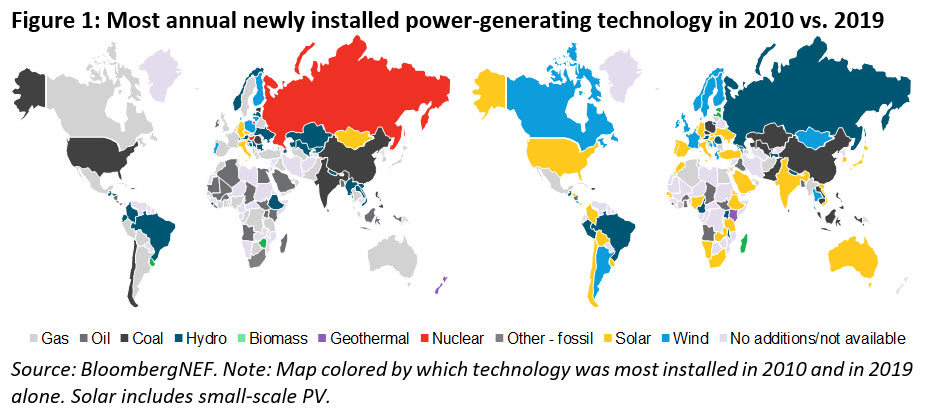PRESS RELEASE
Solar and Wind Reach 67% of New Power Capacity Added Globally in 2019, while Fossil Fuels Slide to 25%
Photovoltaics by far the world’s leading power-generating technology installed in 2019; 45% of capacity added was solar with one third of all countries making it their top choice
New York and São Paulo, September 1, 2020 – Photovoltaics (PV) dominated as the main new power-generating technology source added to grids in dozens of countries ranging from Australia, to India, Italy, Namibia, Uruguay and the U.S. in 2019. With a record 118 gigawatts constructed, PV topped all other technologies in new-build terms and was the most popular technology deployed in a third of nations, according to complete and proprietary data compiled by research company BloombergNEF (BNEF).
In all, 81 countries built at least 1 megawatt of solar during the last calendar year and solar accounted for nearly half of all new power generation capacity constructed worldwide.
The findings are highlighted in BNEF’s new Power Transition Trends 2020 report and online tool, which tracks detailed capacity and generation data over the past decade. Both are based on country-level data compiled by BNEF analysts directly from primary country sources, current through 2019.
The report highlights the enormous strides solar has made in a decade, rising from just 43.7GW of total capacity installed in 2010 to 651GW as of year-end 2019. Solar in 2019 also moved past wind (644GW) to become the fourth largest source of power on a capacity basis, behind coal (2,089GW), gas (1,812GW), and hydro (1,160GW). There is now more wind and solar capacity online worldwide than total capacity from all technologies, clean or dirty, in the U.S.
“Sharp declines in solar equipment costs, namely the modules that go on rooftops and in fields, have made this technology widely available for homes, businesses and grids,” said Luiza Demôro, BNEF analyst and lead author of the study. “PV is now truly ubiquitous and a worldwide phenomenon.”
On a generation basis, solar’s contributions are considerably smaller due to PV’s lower capacity factors compared to fossil fuels. In 2019, solar accounted for 2.7% of electricity generated worldwide, BNEF found, up from 0.16% a decade ago. Given the inexpensive nature of the technology and the limited penetration on a generation basis, BNEF expects the market to continue to grow, with 140-178GW of new solar to be built in 2022.
The data offer other important insights on how the world is generating electricity. From 2018 to 2019, power produced from coal dropped 3% as plants ran less frequently. This marked the first fall in coal generation since 2014-2015 and while the world has far more coal plants online today than a decade ago, those plants are running less often. The average utilization rate at coal-fired power plants has dropped from 57% in 2010 to 50% in 2019. Still, the 9,200 terawatt-hours (TWh) produced from coal in 2019 was up 17% from 2010.
Global coal capacity surged 32% over the decade to reach 2.1TW in 2019. Over 113GW of net coal retirements in developed nations during the 2010s could not offset the 691GW flood of net new coal in emerging markets. In 2019, the world saw 39GW of net new coal capacity installed, up significantly from 2018 when 19GW of coal was completed.
“Wealthier countries are moving quickly to mothball older, largely inefficient coal plants because they can’t compete with new gas or renewables projects,” said Ethan Zindler, head of Americas at BNEF. “However, in less developed nations, particularly in south and southeast Asia, new, more efficient coal plants continue to come on line – often with financial support from Chinese and Japanese lenders.”
Other findings from the new data include:
- Wind and solar accounted for over two-thirds of the 265GW of new capacity installed worldwide in 2019, up from less than a quarter of new build in 2010. For the first time, the two technologies also accounted for the majority of new generation recorded in 2019. Including hydro power, renewables made up three-fourths of 2019 commissioned capacity.
- Wind and solar build was mostly concentrated in wealthier nations during the first half of the 2010s but that has shifted recently. In a group that includes nearly all OECD nations, wind and solar have accounted for the majority of new capacity built each year since 2011. Among a group of non-OECD nations plus Chile, Colombia, Mexico and Turkey, wind and solar have accounted for the majority of annual build each year since 2016.
- BNEF estimates that global power sector CO2 emissions slipped 1.5% 2018-2019 as declines in the U.S. and EU more than offset an increase from China, which accounted for 37% of the 2019 total. The U.S. followed with 14% and the EU with 6%.

The Power Transition Trends 2020 report and tool are based on data collected individually from 138 nations through 2019. This encompasses every country in the world with over two million inhabitants.
Separately, BNEF has been tracking power production in 25 of the world’s largest developed markets daily in 2020. Based on those preliminary data, BNEF expects total global generation, coal generation, and power sector CO2 emissions to fall further in 2020. Emergency responses to Covid-19 have slowed economies and cut electricity demand in at least 20 major nations vs. business-as-usual scenarios calculated by BNEF.
Contact
Veronika Henze
BloombergNEF
+1-646-324-1596
vhenze@bloomberg.net





